Strategic Thinking and Critical Analysis: ASDA Company Report Analysis
VerifiedAdded on 2019/12/18
|20
|7666
|991
Report
AI Summary
This report provides a comprehensive analysis of ASDA, a leading UK retail organization, focusing on strategic thinking and critical analysis. It begins with a situational analysis using the CATWOE framework to assess ASDA's current performance, competitive position, and challenges. The report identifies clients, actors, transformations, worldviews, owners, and environmental constraints to understand the company's operations. It then presents a rich picture illustrating the company's low productivity compared to competitors, the importance of sustainable practices, and the need for improved employee motivation. Progressive resolutions are proposed, including employee motivation techniques, quality control, leadership development, and corporate social governance, such as using solar energy and water conservation. The report emphasizes the importance of adapting to environmental concerns and consumer preferences for eco-friendly practices. Finally, the report highlights the need for ASDA to strengthen its strategies to enhance productivity, shareholder value, and long-term sustainability, thereby gaining a competitive advantage in the market.
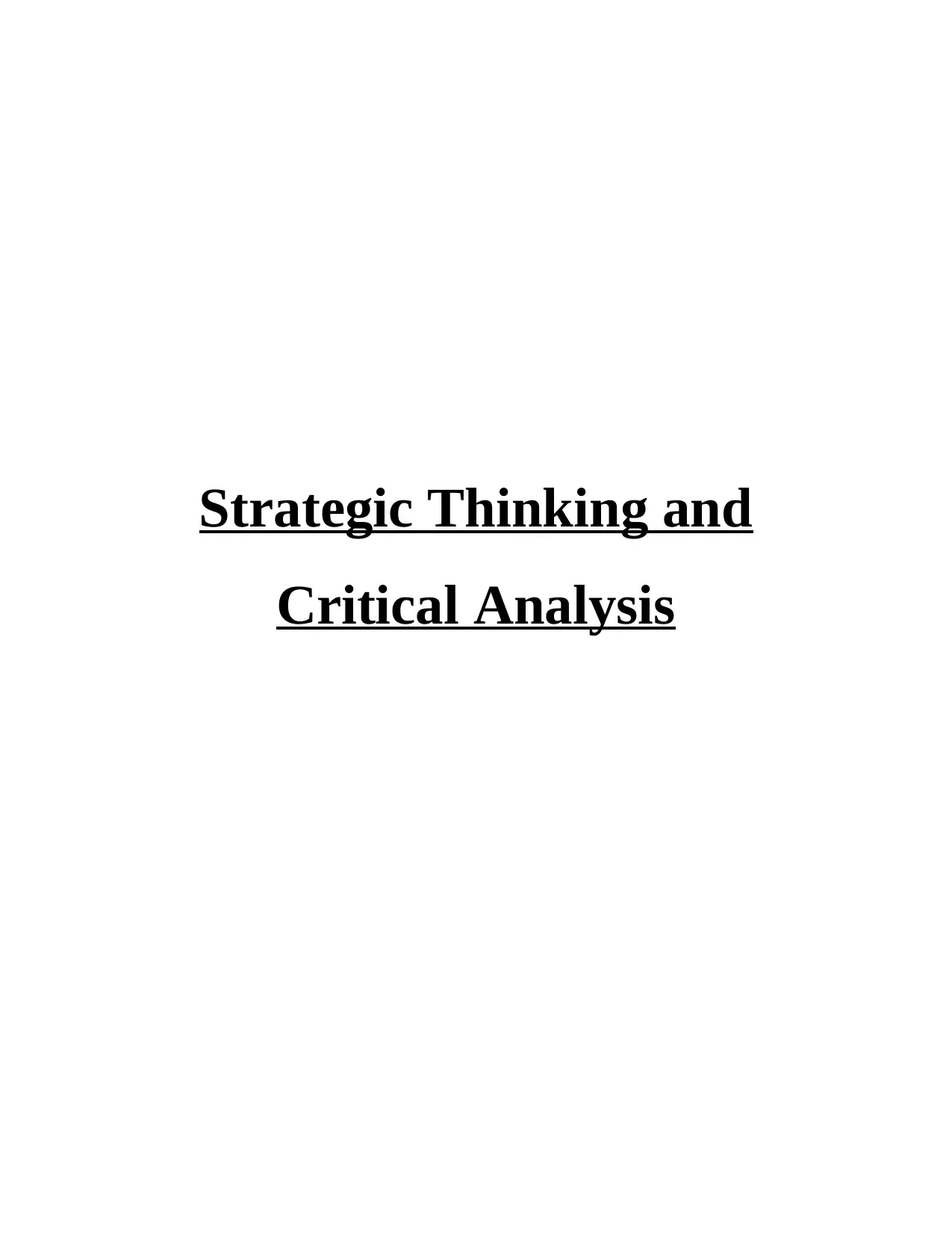
Strategic Thinking and
Critical Analysis
Critical Analysis
Paraphrase This Document
Need a fresh take? Get an instant paraphrase of this document with our AI Paraphraser
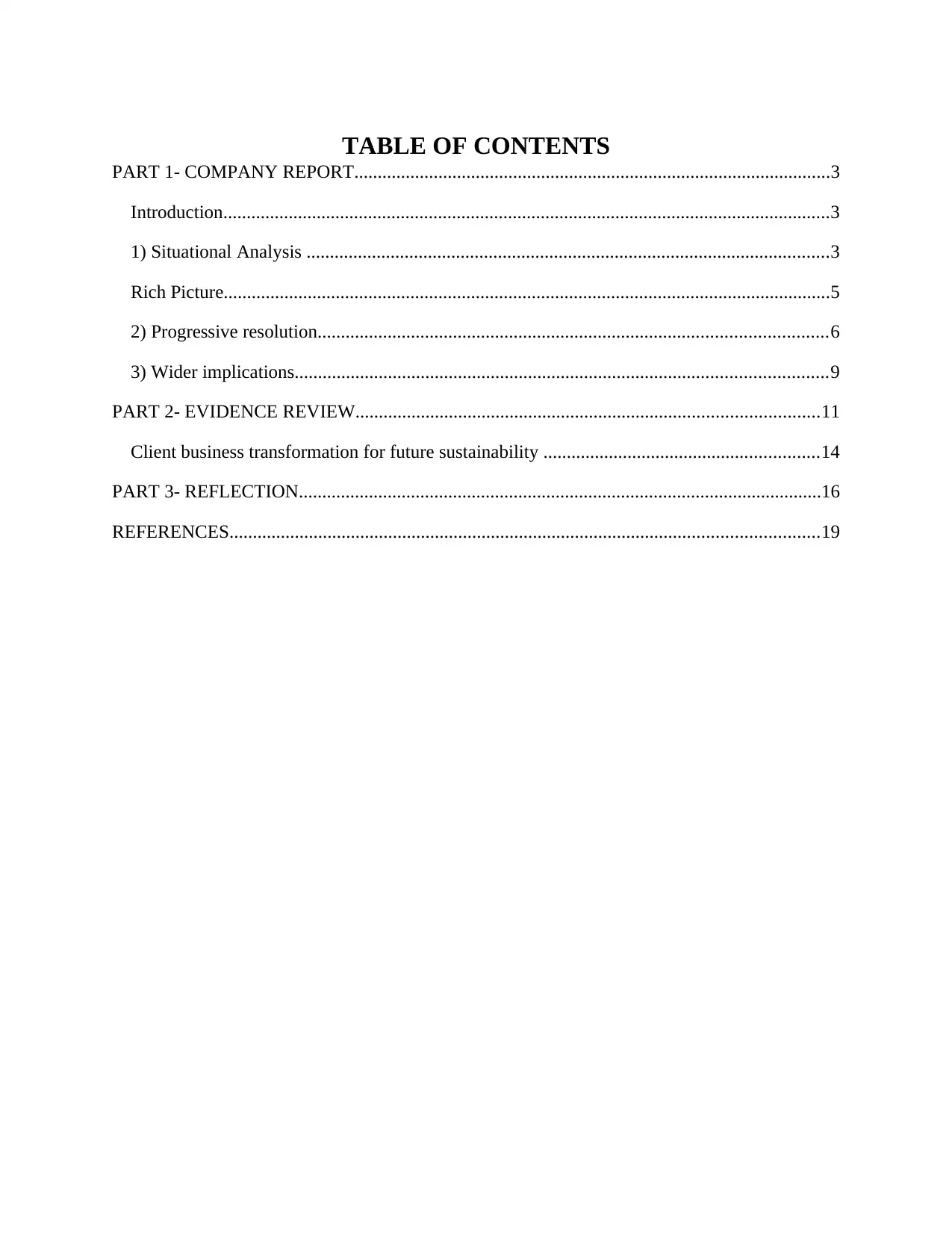
TABLE OF CONTENTS
PART 1- COMPANY REPORT......................................................................................................3
Introduction..................................................................................................................................3
1) Situational Analysis ................................................................................................................3
Rich Picture..................................................................................................................................5
2) Progressive resolution.............................................................................................................6
3) Wider implications..................................................................................................................9
PART 2- EVIDENCE REVIEW...................................................................................................11
Client business transformation for future sustainability ...........................................................14
PART 3- REFLECTION................................................................................................................16
REFERENCES..............................................................................................................................19
PART 1- COMPANY REPORT......................................................................................................3
Introduction..................................................................................................................................3
1) Situational Analysis ................................................................................................................3
Rich Picture..................................................................................................................................5
2) Progressive resolution.............................................................................................................6
3) Wider implications..................................................................................................................9
PART 2- EVIDENCE REVIEW...................................................................................................11
Client business transformation for future sustainability ...........................................................14
PART 3- REFLECTION................................................................................................................16
REFERENCES..............................................................................................................................19
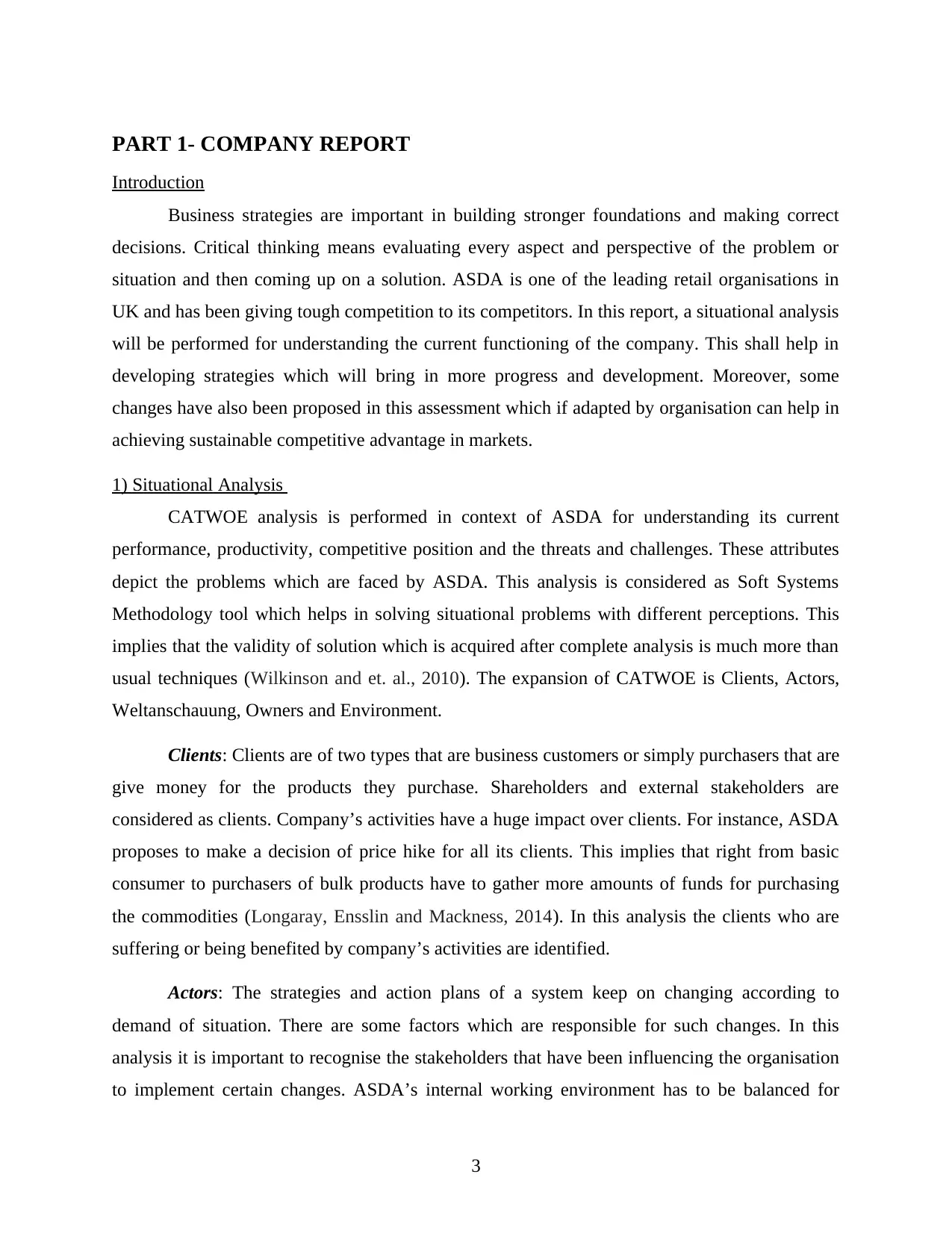
PART 1- COMPANY REPORT
Introduction
Business strategies are important in building stronger foundations and making correct
decisions. Critical thinking means evaluating every aspect and perspective of the problem or
situation and then coming up on a solution. ASDA is one of the leading retail organisations in
UK and has been giving tough competition to its competitors. In this report, a situational analysis
will be performed for understanding the current functioning of the company. This shall help in
developing strategies which will bring in more progress and development. Moreover, some
changes have also been proposed in this assessment which if adapted by organisation can help in
achieving sustainable competitive advantage in markets.
1) Situational Analysis
CATWOE analysis is performed in context of ASDA for understanding its current
performance, productivity, competitive position and the threats and challenges. These attributes
depict the problems which are faced by ASDA. This analysis is considered as Soft Systems
Methodology tool which helps in solving situational problems with different perceptions. This
implies that the validity of solution which is acquired after complete analysis is much more than
usual techniques (Wilkinson and et. al., 2010). The expansion of CATWOE is Clients, Actors,
Weltanschauung, Owners and Environment.
Clients: Clients are of two types that are business customers or simply purchasers that are
give money for the products they purchase. Shareholders and external stakeholders are
considered as clients. Company’s activities have a huge impact over clients. For instance, ASDA
proposes to make a decision of price hike for all its clients. This implies that right from basic
consumer to purchasers of bulk products have to gather more amounts of funds for purchasing
the commodities (Longaray, Ensslin and Mackness, 2014). In this analysis the clients who are
suffering or being benefited by company’s activities are identified.
Actors: The strategies and action plans of a system keep on changing according to
demand of situation. There are some factors which are responsible for such changes. In this
analysis it is important to recognise the stakeholders that have been influencing the organisation
to implement certain changes. ASDA’s internal working environment has to be balanced for
3
Introduction
Business strategies are important in building stronger foundations and making correct
decisions. Critical thinking means evaluating every aspect and perspective of the problem or
situation and then coming up on a solution. ASDA is one of the leading retail organisations in
UK and has been giving tough competition to its competitors. In this report, a situational analysis
will be performed for understanding the current functioning of the company. This shall help in
developing strategies which will bring in more progress and development. Moreover, some
changes have also been proposed in this assessment which if adapted by organisation can help in
achieving sustainable competitive advantage in markets.
1) Situational Analysis
CATWOE analysis is performed in context of ASDA for understanding its current
performance, productivity, competitive position and the threats and challenges. These attributes
depict the problems which are faced by ASDA. This analysis is considered as Soft Systems
Methodology tool which helps in solving situational problems with different perceptions. This
implies that the validity of solution which is acquired after complete analysis is much more than
usual techniques (Wilkinson and et. al., 2010). The expansion of CATWOE is Clients, Actors,
Weltanschauung, Owners and Environment.
Clients: Clients are of two types that are business customers or simply purchasers that are
give money for the products they purchase. Shareholders and external stakeholders are
considered as clients. Company’s activities have a huge impact over clients. For instance, ASDA
proposes to make a decision of price hike for all its clients. This implies that right from basic
consumer to purchasers of bulk products have to gather more amounts of funds for purchasing
the commodities (Longaray, Ensslin and Mackness, 2014). In this analysis the clients who are
suffering or being benefited by company’s activities are identified.
Actors: The strategies and action plans of a system keep on changing according to
demand of situation. There are some factors which are responsible for such changes. In this
analysis it is important to recognise the stakeholders that have been influencing the organisation
to implement certain changes. ASDA’s internal working environment has to be balanced for
3
⊘ This is a preview!⊘
Do you want full access?
Subscribe today to unlock all pages.

Trusted by 1+ million students worldwide
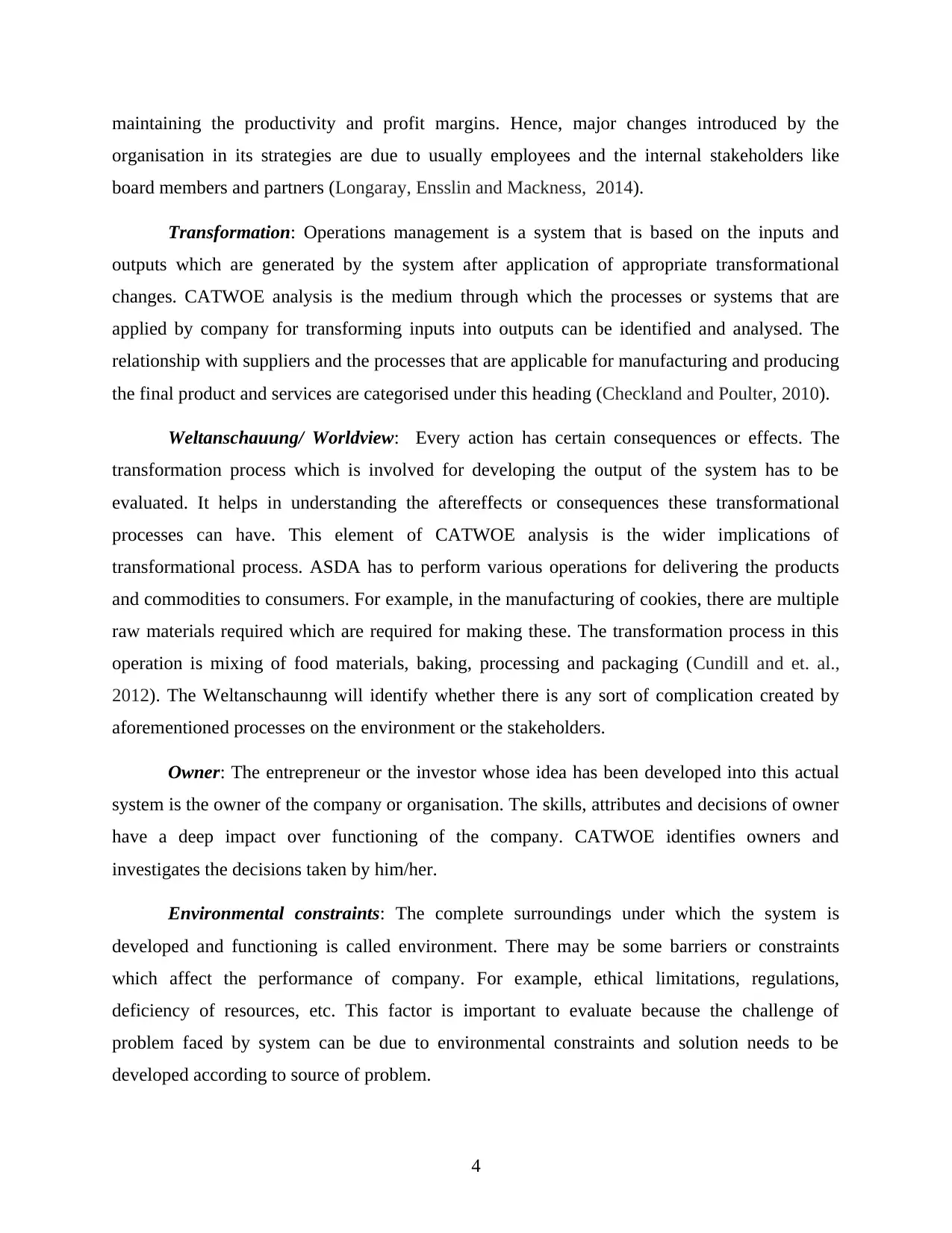
maintaining the productivity and profit margins. Hence, major changes introduced by the
organisation in its strategies are due to usually employees and the internal stakeholders like
board members and partners (Longaray, Ensslin and Mackness, 2014).
Transformation: Operations management is a system that is based on the inputs and
outputs which are generated by the system after application of appropriate transformational
changes. CATWOE analysis is the medium through which the processes or systems that are
applied by company for transforming inputs into outputs can be identified and analysed. The
relationship with suppliers and the processes that are applicable for manufacturing and producing
the final product and services are categorised under this heading (Checkland and Poulter, 2010).
Weltanschauung/ Worldview: Every action has certain consequences or effects. The
transformation process which is involved for developing the output of the system has to be
evaluated. It helps in understanding the aftereffects or consequences these transformational
processes can have. This element of CATWOE analysis is the wider implications of
transformational process. ASDA has to perform various operations for delivering the products
and commodities to consumers. For example, in the manufacturing of cookies, there are multiple
raw materials required which are required for making these. The transformation process in this
operation is mixing of food materials, baking, processing and packaging (Cundill and et. al.,
2012). The Weltanschaunng will identify whether there is any sort of complication created by
aforementioned processes on the environment or the stakeholders.
Owner: The entrepreneur or the investor whose idea has been developed into this actual
system is the owner of the company or organisation. The skills, attributes and decisions of owner
have a deep impact over functioning of the company. CATWOE identifies owners and
investigates the decisions taken by him/her.
Environmental constraints: The complete surroundings under which the system is
developed and functioning is called environment. There may be some barriers or constraints
which affect the performance of company. For example, ethical limitations, regulations,
deficiency of resources, etc. This factor is important to evaluate because the challenge of
problem faced by system can be due to environmental constraints and solution needs to be
developed according to source of problem.
4
organisation in its strategies are due to usually employees and the internal stakeholders like
board members and partners (Longaray, Ensslin and Mackness, 2014).
Transformation: Operations management is a system that is based on the inputs and
outputs which are generated by the system after application of appropriate transformational
changes. CATWOE analysis is the medium through which the processes or systems that are
applied by company for transforming inputs into outputs can be identified and analysed. The
relationship with suppliers and the processes that are applicable for manufacturing and producing
the final product and services are categorised under this heading (Checkland and Poulter, 2010).
Weltanschauung/ Worldview: Every action has certain consequences or effects. The
transformation process which is involved for developing the output of the system has to be
evaluated. It helps in understanding the aftereffects or consequences these transformational
processes can have. This element of CATWOE analysis is the wider implications of
transformational process. ASDA has to perform various operations for delivering the products
and commodities to consumers. For example, in the manufacturing of cookies, there are multiple
raw materials required which are required for making these. The transformation process in this
operation is mixing of food materials, baking, processing and packaging (Cundill and et. al.,
2012). The Weltanschaunng will identify whether there is any sort of complication created by
aforementioned processes on the environment or the stakeholders.
Owner: The entrepreneur or the investor whose idea has been developed into this actual
system is the owner of the company or organisation. The skills, attributes and decisions of owner
have a deep impact over functioning of the company. CATWOE identifies owners and
investigates the decisions taken by him/her.
Environmental constraints: The complete surroundings under which the system is
developed and functioning is called environment. There may be some barriers or constraints
which affect the performance of company. For example, ethical limitations, regulations,
deficiency of resources, etc. This factor is important to evaluate because the challenge of
problem faced by system can be due to environmental constraints and solution needs to be
developed according to source of problem.
4
Paraphrase This Document
Need a fresh take? Get an instant paraphrase of this document with our AI Paraphraser
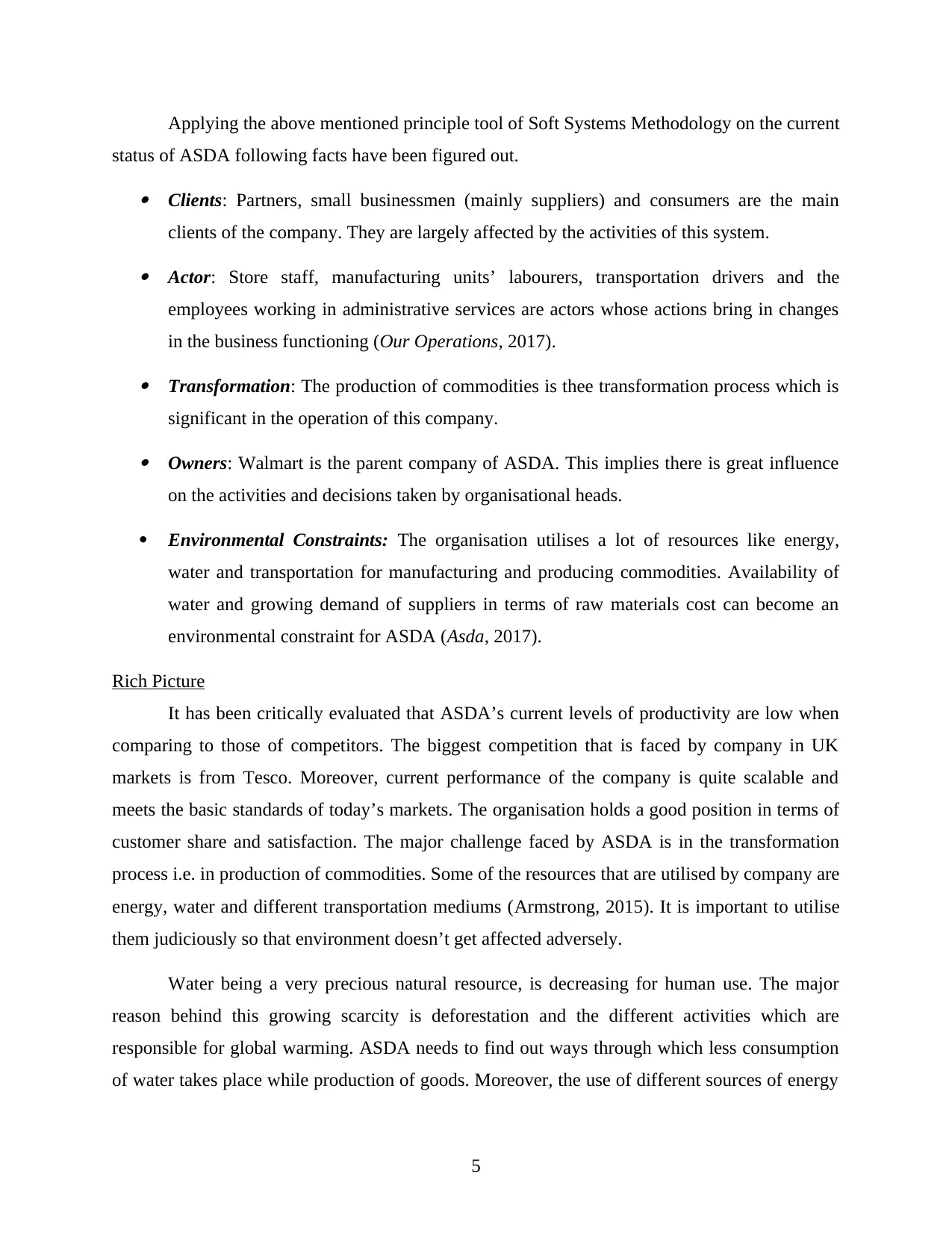
Applying the above mentioned principle tool of Soft Systems Methodology on the current
status of ASDA following facts have been figured out. Clients: Partners, small businessmen (mainly suppliers) and consumers are the main
clients of the company. They are largely affected by the activities of this system. Actor: Store staff, manufacturing units’ labourers, transportation drivers and the
employees working in administrative services are actors whose actions bring in changes
in the business functioning (Our Operations, 2017). Transformation: The production of commodities is thee transformation process which is
significant in the operation of this company. Owners: Walmart is the parent company of ASDA. This implies there is great influence
on the activities and decisions taken by organisational heads.
Environmental Constraints: The organisation utilises a lot of resources like energy,
water and transportation for manufacturing and producing commodities. Availability of
water and growing demand of suppliers in terms of raw materials cost can become an
environmental constraint for ASDA (Asda, 2017).
Rich Picture
It has been critically evaluated that ASDA’s current levels of productivity are low when
comparing to those of competitors. The biggest competition that is faced by company in UK
markets is from Tesco. Moreover, current performance of the company is quite scalable and
meets the basic standards of today’s markets. The organisation holds a good position in terms of
customer share and satisfaction. The major challenge faced by ASDA is in the transformation
process i.e. in production of commodities. Some of the resources that are utilised by company are
energy, water and different transportation mediums (Armstrong, 2015). It is important to utilise
them judiciously so that environment doesn’t get affected adversely.
Water being a very precious natural resource, is decreasing for human use. The major
reason behind this growing scarcity is deforestation and the different activities which are
responsible for global warming. ASDA needs to find out ways through which less consumption
of water takes place while production of goods. Moreover, the use of different sources of energy
5
status of ASDA following facts have been figured out. Clients: Partners, small businessmen (mainly suppliers) and consumers are the main
clients of the company. They are largely affected by the activities of this system. Actor: Store staff, manufacturing units’ labourers, transportation drivers and the
employees working in administrative services are actors whose actions bring in changes
in the business functioning (Our Operations, 2017). Transformation: The production of commodities is thee transformation process which is
significant in the operation of this company. Owners: Walmart is the parent company of ASDA. This implies there is great influence
on the activities and decisions taken by organisational heads.
Environmental Constraints: The organisation utilises a lot of resources like energy,
water and transportation for manufacturing and producing commodities. Availability of
water and growing demand of suppliers in terms of raw materials cost can become an
environmental constraint for ASDA (Asda, 2017).
Rich Picture
It has been critically evaluated that ASDA’s current levels of productivity are low when
comparing to those of competitors. The biggest competition that is faced by company in UK
markets is from Tesco. Moreover, current performance of the company is quite scalable and
meets the basic standards of today’s markets. The organisation holds a good position in terms of
customer share and satisfaction. The major challenge faced by ASDA is in the transformation
process i.e. in production of commodities. Some of the resources that are utilised by company are
energy, water and different transportation mediums (Armstrong, 2015). It is important to utilise
them judiciously so that environment doesn’t get affected adversely.
Water being a very precious natural resource, is decreasing for human use. The major
reason behind this growing scarcity is deforestation and the different activities which are
responsible for global warming. ASDA needs to find out ways through which less consumption
of water takes place while production of goods. Moreover, the use of different sources of energy
5
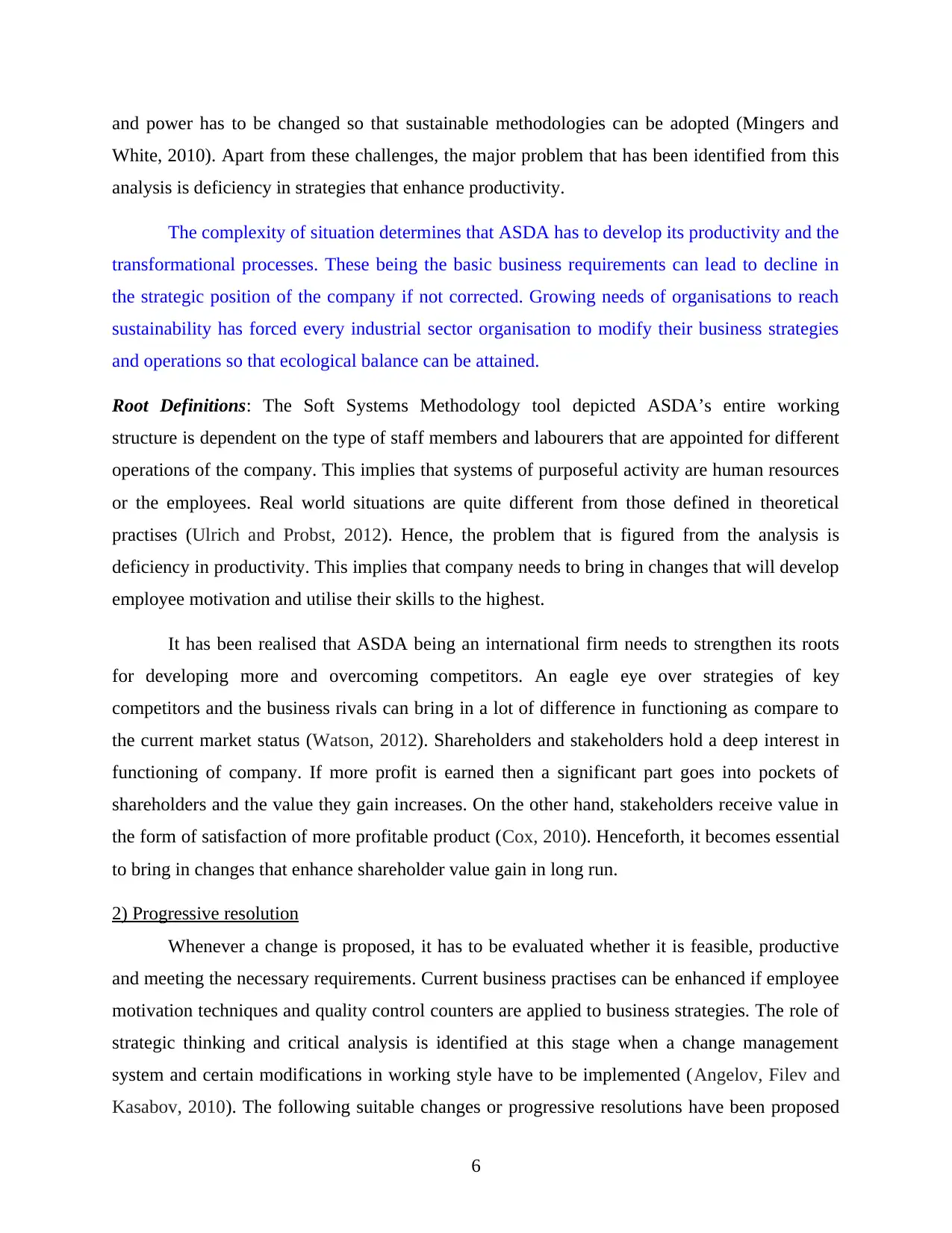
and power has to be changed so that sustainable methodologies can be adopted (Mingers and
White, 2010). Apart from these challenges, the major problem that has been identified from this
analysis is deficiency in strategies that enhance productivity.
The complexity of situation determines that ASDA has to develop its productivity and the
transformational processes. These being the basic business requirements can lead to decline in
the strategic position of the company if not corrected. Growing needs of organisations to reach
sustainability has forced every industrial sector organisation to modify their business strategies
and operations so that ecological balance can be attained.
Root Definitions: The Soft Systems Methodology tool depicted ASDA’s entire working
structure is dependent on the type of staff members and labourers that are appointed for different
operations of the company. This implies that systems of purposeful activity are human resources
or the employees. Real world situations are quite different from those defined in theoretical
practises (Ulrich and Probst, 2012). Hence, the problem that is figured from the analysis is
deficiency in productivity. This implies that company needs to bring in changes that will develop
employee motivation and utilise their skills to the highest.
It has been realised that ASDA being an international firm needs to strengthen its roots
for developing more and overcoming competitors. An eagle eye over strategies of key
competitors and the business rivals can bring in a lot of difference in functioning as compare to
the current market status (Watson, 2012). Shareholders and stakeholders hold a deep interest in
functioning of company. If more profit is earned then a significant part goes into pockets of
shareholders and the value they gain increases. On the other hand, stakeholders receive value in
the form of satisfaction of more profitable product (Cox, 2010). Henceforth, it becomes essential
to bring in changes that enhance shareholder value gain in long run.
2) Progressive resolution
Whenever a change is proposed, it has to be evaluated whether it is feasible, productive
and meeting the necessary requirements. Current business practises can be enhanced if employee
motivation techniques and quality control counters are applied to business strategies. The role of
strategic thinking and critical analysis is identified at this stage when a change management
system and certain modifications in working style have to be implemented (Angelov, Filev and
Kasabov, 2010). The following suitable changes or progressive resolutions have been proposed
6
White, 2010). Apart from these challenges, the major problem that has been identified from this
analysis is deficiency in strategies that enhance productivity.
The complexity of situation determines that ASDA has to develop its productivity and the
transformational processes. These being the basic business requirements can lead to decline in
the strategic position of the company if not corrected. Growing needs of organisations to reach
sustainability has forced every industrial sector organisation to modify their business strategies
and operations so that ecological balance can be attained.
Root Definitions: The Soft Systems Methodology tool depicted ASDA’s entire working
structure is dependent on the type of staff members and labourers that are appointed for different
operations of the company. This implies that systems of purposeful activity are human resources
or the employees. Real world situations are quite different from those defined in theoretical
practises (Ulrich and Probst, 2012). Hence, the problem that is figured from the analysis is
deficiency in productivity. This implies that company needs to bring in changes that will develop
employee motivation and utilise their skills to the highest.
It has been realised that ASDA being an international firm needs to strengthen its roots
for developing more and overcoming competitors. An eagle eye over strategies of key
competitors and the business rivals can bring in a lot of difference in functioning as compare to
the current market status (Watson, 2012). Shareholders and stakeholders hold a deep interest in
functioning of company. If more profit is earned then a significant part goes into pockets of
shareholders and the value they gain increases. On the other hand, stakeholders receive value in
the form of satisfaction of more profitable product (Cox, 2010). Henceforth, it becomes essential
to bring in changes that enhance shareholder value gain in long run.
2) Progressive resolution
Whenever a change is proposed, it has to be evaluated whether it is feasible, productive
and meeting the necessary requirements. Current business practises can be enhanced if employee
motivation techniques and quality control counters are applied to business strategies. The role of
strategic thinking and critical analysis is identified at this stage when a change management
system and certain modifications in working style have to be implemented (Angelov, Filev and
Kasabov, 2010). The following suitable changes or progressive resolutions have been proposed
6
⊘ This is a preview!⊘
Do you want full access?
Subscribe today to unlock all pages.

Trusted by 1+ million students worldwide
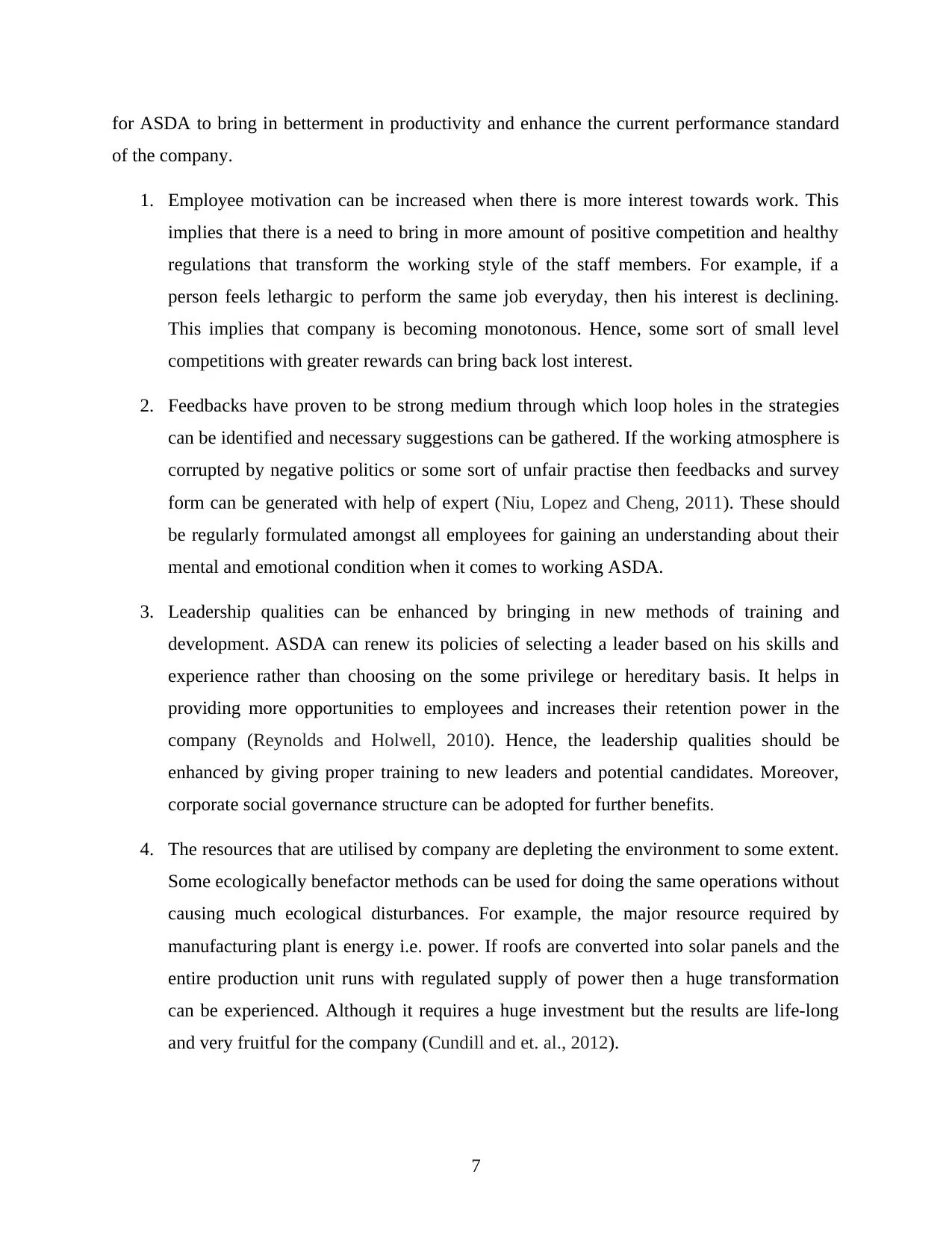
for ASDA to bring in betterment in productivity and enhance the current performance standard
of the company.
1. Employee motivation can be increased when there is more interest towards work. This
implies that there is a need to bring in more amount of positive competition and healthy
regulations that transform the working style of the staff members. For example, if a
person feels lethargic to perform the same job everyday, then his interest is declining.
This implies that company is becoming monotonous. Hence, some sort of small level
competitions with greater rewards can bring back lost interest.
2. Feedbacks have proven to be strong medium through which loop holes in the strategies
can be identified and necessary suggestions can be gathered. If the working atmosphere is
corrupted by negative politics or some sort of unfair practise then feedbacks and survey
form can be generated with help of expert (Niu, Lopez and Cheng, 2011). These should
be regularly formulated amongst all employees for gaining an understanding about their
mental and emotional condition when it comes to working ASDA.
3. Leadership qualities can be enhanced by bringing in new methods of training and
development. ASDA can renew its policies of selecting a leader based on his skills and
experience rather than choosing on the some privilege or hereditary basis. It helps in
providing more opportunities to employees and increases their retention power in the
company (Reynolds and Holwell, 2010). Hence, the leadership qualities should be
enhanced by giving proper training to new leaders and potential candidates. Moreover,
corporate social governance structure can be adopted for further benefits.
4. The resources that are utilised by company are depleting the environment to some extent.
Some ecologically benefactor methods can be used for doing the same operations without
causing much ecological disturbances. For example, the major resource required by
manufacturing plant is energy i.e. power. If roofs are converted into solar panels and the
entire production unit runs with regulated supply of power then a huge transformation
can be experienced. Although it requires a huge investment but the results are life-long
and very fruitful for the company (Cundill and et. al., 2012).
7
of the company.
1. Employee motivation can be increased when there is more interest towards work. This
implies that there is a need to bring in more amount of positive competition and healthy
regulations that transform the working style of the staff members. For example, if a
person feels lethargic to perform the same job everyday, then his interest is declining.
This implies that company is becoming monotonous. Hence, some sort of small level
competitions with greater rewards can bring back lost interest.
2. Feedbacks have proven to be strong medium through which loop holes in the strategies
can be identified and necessary suggestions can be gathered. If the working atmosphere is
corrupted by negative politics or some sort of unfair practise then feedbacks and survey
form can be generated with help of expert (Niu, Lopez and Cheng, 2011). These should
be regularly formulated amongst all employees for gaining an understanding about their
mental and emotional condition when it comes to working ASDA.
3. Leadership qualities can be enhanced by bringing in new methods of training and
development. ASDA can renew its policies of selecting a leader based on his skills and
experience rather than choosing on the some privilege or hereditary basis. It helps in
providing more opportunities to employees and increases their retention power in the
company (Reynolds and Holwell, 2010). Hence, the leadership qualities should be
enhanced by giving proper training to new leaders and potential candidates. Moreover,
corporate social governance structure can be adopted for further benefits.
4. The resources that are utilised by company are depleting the environment to some extent.
Some ecologically benefactor methods can be used for doing the same operations without
causing much ecological disturbances. For example, the major resource required by
manufacturing plant is energy i.e. power. If roofs are converted into solar panels and the
entire production unit runs with regulated supply of power then a huge transformation
can be experienced. Although it requires a huge investment but the results are life-long
and very fruitful for the company (Cundill and et. al., 2012).
7
Paraphrase This Document
Need a fresh take? Get an instant paraphrase of this document with our AI Paraphraser
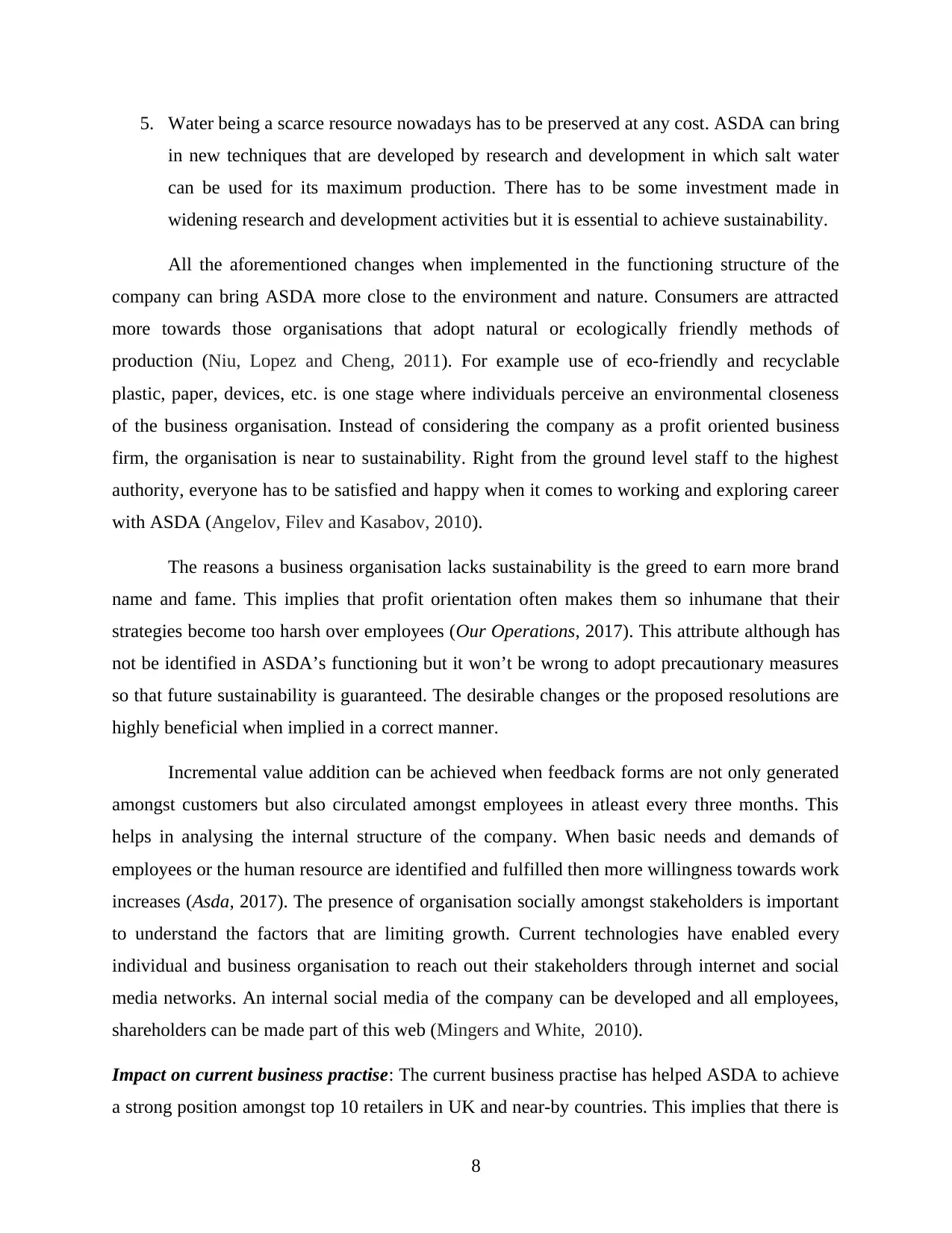
5. Water being a scarce resource nowadays has to be preserved at any cost. ASDA can bring
in new techniques that are developed by research and development in which salt water
can be used for its maximum production. There has to be some investment made in
widening research and development activities but it is essential to achieve sustainability.
All the aforementioned changes when implemented in the functioning structure of the
company can bring ASDA more close to the environment and nature. Consumers are attracted
more towards those organisations that adopt natural or ecologically friendly methods of
production (Niu, Lopez and Cheng, 2011). For example use of eco-friendly and recyclable
plastic, paper, devices, etc. is one stage where individuals perceive an environmental closeness
of the business organisation. Instead of considering the company as a profit oriented business
firm, the organisation is near to sustainability. Right from the ground level staff to the highest
authority, everyone has to be satisfied and happy when it comes to working and exploring career
with ASDA (Angelov, Filev and Kasabov, 2010).
The reasons a business organisation lacks sustainability is the greed to earn more brand
name and fame. This implies that profit orientation often makes them so inhumane that their
strategies become too harsh over employees (Our Operations, 2017). This attribute although has
not be identified in ASDA’s functioning but it won’t be wrong to adopt precautionary measures
so that future sustainability is guaranteed. The desirable changes or the proposed resolutions are
highly beneficial when implied in a correct manner.
Incremental value addition can be achieved when feedback forms are not only generated
amongst customers but also circulated amongst employees in atleast every three months. This
helps in analysing the internal structure of the company. When basic needs and demands of
employees or the human resource are identified and fulfilled then more willingness towards work
increases (Asda, 2017). The presence of organisation socially amongst stakeholders is important
to understand the factors that are limiting growth. Current technologies have enabled every
individual and business organisation to reach out their stakeholders through internet and social
media networks. An internal social media of the company can be developed and all employees,
shareholders can be made part of this web (Mingers and White, 2010).
Impact on current business practise: The current business practise has helped ASDA to achieve
a strong position amongst top 10 retailers in UK and near-by countries. This implies that there is
8
in new techniques that are developed by research and development in which salt water
can be used for its maximum production. There has to be some investment made in
widening research and development activities but it is essential to achieve sustainability.
All the aforementioned changes when implemented in the functioning structure of the
company can bring ASDA more close to the environment and nature. Consumers are attracted
more towards those organisations that adopt natural or ecologically friendly methods of
production (Niu, Lopez and Cheng, 2011). For example use of eco-friendly and recyclable
plastic, paper, devices, etc. is one stage where individuals perceive an environmental closeness
of the business organisation. Instead of considering the company as a profit oriented business
firm, the organisation is near to sustainability. Right from the ground level staff to the highest
authority, everyone has to be satisfied and happy when it comes to working and exploring career
with ASDA (Angelov, Filev and Kasabov, 2010).
The reasons a business organisation lacks sustainability is the greed to earn more brand
name and fame. This implies that profit orientation often makes them so inhumane that their
strategies become too harsh over employees (Our Operations, 2017). This attribute although has
not be identified in ASDA’s functioning but it won’t be wrong to adopt precautionary measures
so that future sustainability is guaranteed. The desirable changes or the proposed resolutions are
highly beneficial when implied in a correct manner.
Incremental value addition can be achieved when feedback forms are not only generated
amongst customers but also circulated amongst employees in atleast every three months. This
helps in analysing the internal structure of the company. When basic needs and demands of
employees or the human resource are identified and fulfilled then more willingness towards work
increases (Asda, 2017). The presence of organisation socially amongst stakeholders is important
to understand the factors that are limiting growth. Current technologies have enabled every
individual and business organisation to reach out their stakeholders through internet and social
media networks. An internal social media of the company can be developed and all employees,
shareholders can be made part of this web (Mingers and White, 2010).
Impact on current business practise: The current business practise has helped ASDA to achieve
a strong position amongst top 10 retailers in UK and near-by countries. This implies that there is
8
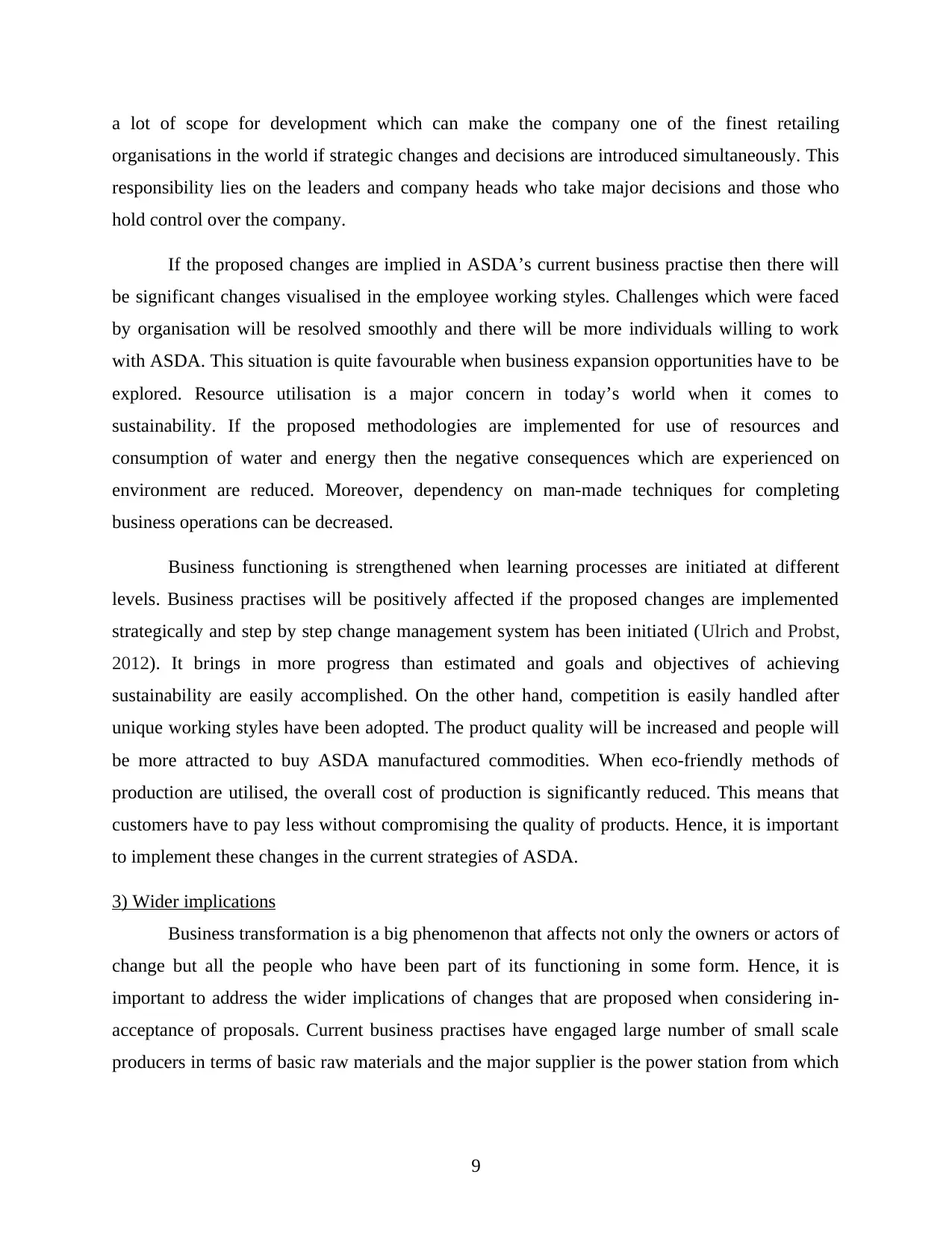
a lot of scope for development which can make the company one of the finest retailing
organisations in the world if strategic changes and decisions are introduced simultaneously. This
responsibility lies on the leaders and company heads who take major decisions and those who
hold control over the company.
If the proposed changes are implied in ASDA’s current business practise then there will
be significant changes visualised in the employee working styles. Challenges which were faced
by organisation will be resolved smoothly and there will be more individuals willing to work
with ASDA. This situation is quite favourable when business expansion opportunities have to be
explored. Resource utilisation is a major concern in today’s world when it comes to
sustainability. If the proposed methodologies are implemented for use of resources and
consumption of water and energy then the negative consequences which are experienced on
environment are reduced. Moreover, dependency on man-made techniques for completing
business operations can be decreased.
Business functioning is strengthened when learning processes are initiated at different
levels. Business practises will be positively affected if the proposed changes are implemented
strategically and step by step change management system has been initiated (Ulrich and Probst,
2012). It brings in more progress than estimated and goals and objectives of achieving
sustainability are easily accomplished. On the other hand, competition is easily handled after
unique working styles have been adopted. The product quality will be increased and people will
be more attracted to buy ASDA manufactured commodities. When eco-friendly methods of
production are utilised, the overall cost of production is significantly reduced. This means that
customers have to pay less without compromising the quality of products. Hence, it is important
to implement these changes in the current strategies of ASDA.
3) Wider implications
Business transformation is a big phenomenon that affects not only the owners or actors of
change but all the people who have been part of its functioning in some form. Hence, it is
important to address the wider implications of changes that are proposed when considering in-
acceptance of proposals. Current business practises have engaged large number of small scale
producers in terms of basic raw materials and the major supplier is the power station from which
9
organisations in the world if strategic changes and decisions are introduced simultaneously. This
responsibility lies on the leaders and company heads who take major decisions and those who
hold control over the company.
If the proposed changes are implied in ASDA’s current business practise then there will
be significant changes visualised in the employee working styles. Challenges which were faced
by organisation will be resolved smoothly and there will be more individuals willing to work
with ASDA. This situation is quite favourable when business expansion opportunities have to be
explored. Resource utilisation is a major concern in today’s world when it comes to
sustainability. If the proposed methodologies are implemented for use of resources and
consumption of water and energy then the negative consequences which are experienced on
environment are reduced. Moreover, dependency on man-made techniques for completing
business operations can be decreased.
Business functioning is strengthened when learning processes are initiated at different
levels. Business practises will be positively affected if the proposed changes are implemented
strategically and step by step change management system has been initiated (Ulrich and Probst,
2012). It brings in more progress than estimated and goals and objectives of achieving
sustainability are easily accomplished. On the other hand, competition is easily handled after
unique working styles have been adopted. The product quality will be increased and people will
be more attracted to buy ASDA manufactured commodities. When eco-friendly methods of
production are utilised, the overall cost of production is significantly reduced. This means that
customers have to pay less without compromising the quality of products. Hence, it is important
to implement these changes in the current strategies of ASDA.
3) Wider implications
Business transformation is a big phenomenon that affects not only the owners or actors of
change but all the people who have been part of its functioning in some form. Hence, it is
important to address the wider implications of changes that are proposed when considering in-
acceptance of proposals. Current business practises have engaged large number of small scale
producers in terms of basic raw materials and the major supplier is the power station from which
9
⊘ This is a preview!⊘
Do you want full access?
Subscribe today to unlock all pages.

Trusted by 1+ million students worldwide
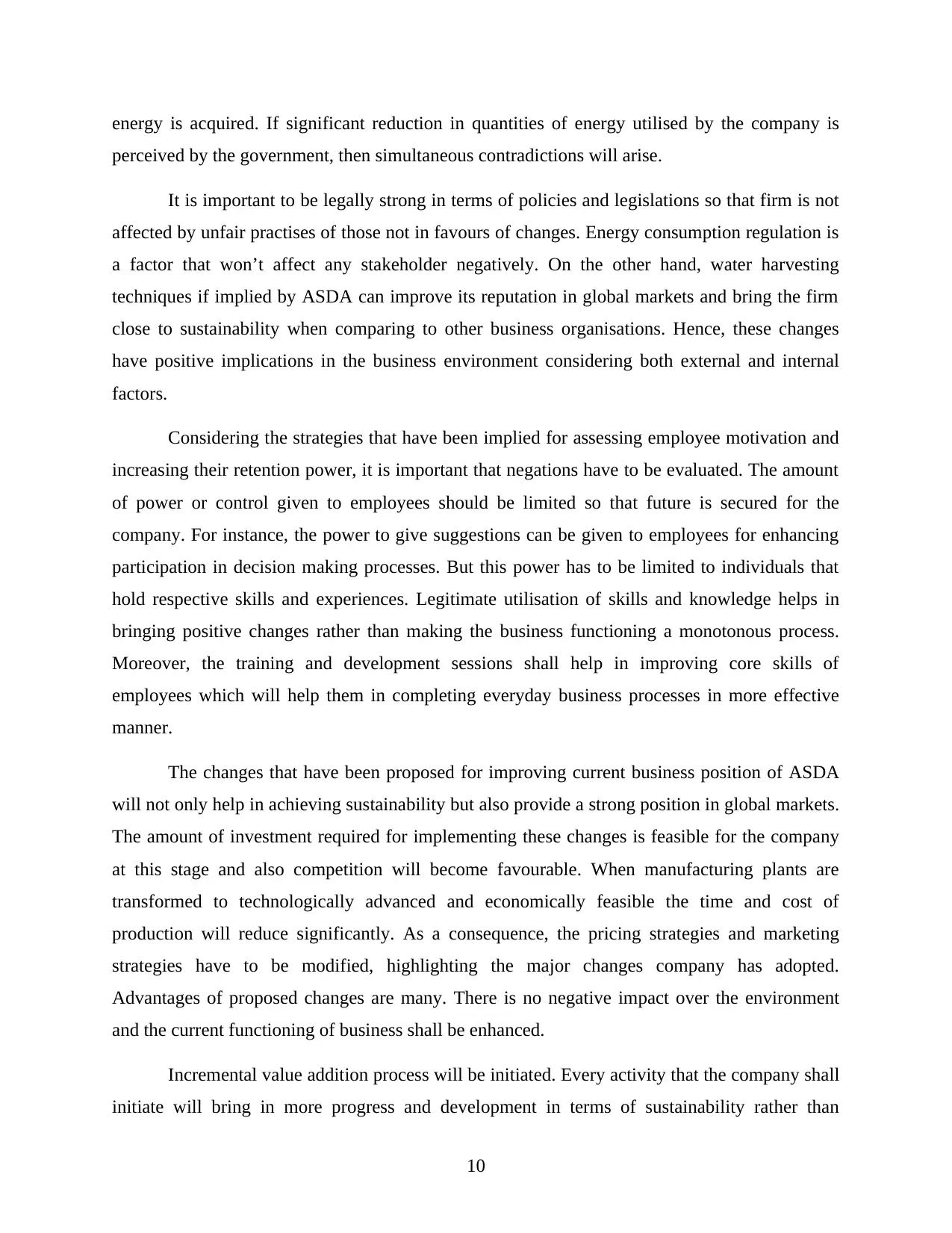
energy is acquired. If significant reduction in quantities of energy utilised by the company is
perceived by the government, then simultaneous contradictions will arise.
It is important to be legally strong in terms of policies and legislations so that firm is not
affected by unfair practises of those not in favours of changes. Energy consumption regulation is
a factor that won’t affect any stakeholder negatively. On the other hand, water harvesting
techniques if implied by ASDA can improve its reputation in global markets and bring the firm
close to sustainability when comparing to other business organisations. Hence, these changes
have positive implications in the business environment considering both external and internal
factors.
Considering the strategies that have been implied for assessing employee motivation and
increasing their retention power, it is important that negations have to be evaluated. The amount
of power or control given to employees should be limited so that future is secured for the
company. For instance, the power to give suggestions can be given to employees for enhancing
participation in decision making processes. But this power has to be limited to individuals that
hold respective skills and experiences. Legitimate utilisation of skills and knowledge helps in
bringing positive changes rather than making the business functioning a monotonous process.
Moreover, the training and development sessions shall help in improving core skills of
employees which will help them in completing everyday business processes in more effective
manner.
The changes that have been proposed for improving current business position of ASDA
will not only help in achieving sustainability but also provide a strong position in global markets.
The amount of investment required for implementing these changes is feasible for the company
at this stage and also competition will become favourable. When manufacturing plants are
transformed to technologically advanced and economically feasible the time and cost of
production will reduce significantly. As a consequence, the pricing strategies and marketing
strategies have to be modified, highlighting the major changes company has adopted.
Advantages of proposed changes are many. There is no negative impact over the environment
and the current functioning of business shall be enhanced.
Incremental value addition process will be initiated. Every activity that the company shall
initiate will bring in more progress and development in terms of sustainability rather than
10
perceived by the government, then simultaneous contradictions will arise.
It is important to be legally strong in terms of policies and legislations so that firm is not
affected by unfair practises of those not in favours of changes. Energy consumption regulation is
a factor that won’t affect any stakeholder negatively. On the other hand, water harvesting
techniques if implied by ASDA can improve its reputation in global markets and bring the firm
close to sustainability when comparing to other business organisations. Hence, these changes
have positive implications in the business environment considering both external and internal
factors.
Considering the strategies that have been implied for assessing employee motivation and
increasing their retention power, it is important that negations have to be evaluated. The amount
of power or control given to employees should be limited so that future is secured for the
company. For instance, the power to give suggestions can be given to employees for enhancing
participation in decision making processes. But this power has to be limited to individuals that
hold respective skills and experiences. Legitimate utilisation of skills and knowledge helps in
bringing positive changes rather than making the business functioning a monotonous process.
Moreover, the training and development sessions shall help in improving core skills of
employees which will help them in completing everyday business processes in more effective
manner.
The changes that have been proposed for improving current business position of ASDA
will not only help in achieving sustainability but also provide a strong position in global markets.
The amount of investment required for implementing these changes is feasible for the company
at this stage and also competition will become favourable. When manufacturing plants are
transformed to technologically advanced and economically feasible the time and cost of
production will reduce significantly. As a consequence, the pricing strategies and marketing
strategies have to be modified, highlighting the major changes company has adopted.
Advantages of proposed changes are many. There is no negative impact over the environment
and the current functioning of business shall be enhanced.
Incremental value addition process will be initiated. Every activity that the company shall
initiate will bring in more progress and development in terms of sustainability rather than
10
Paraphrase This Document
Need a fresh take? Get an instant paraphrase of this document with our AI Paraphraser
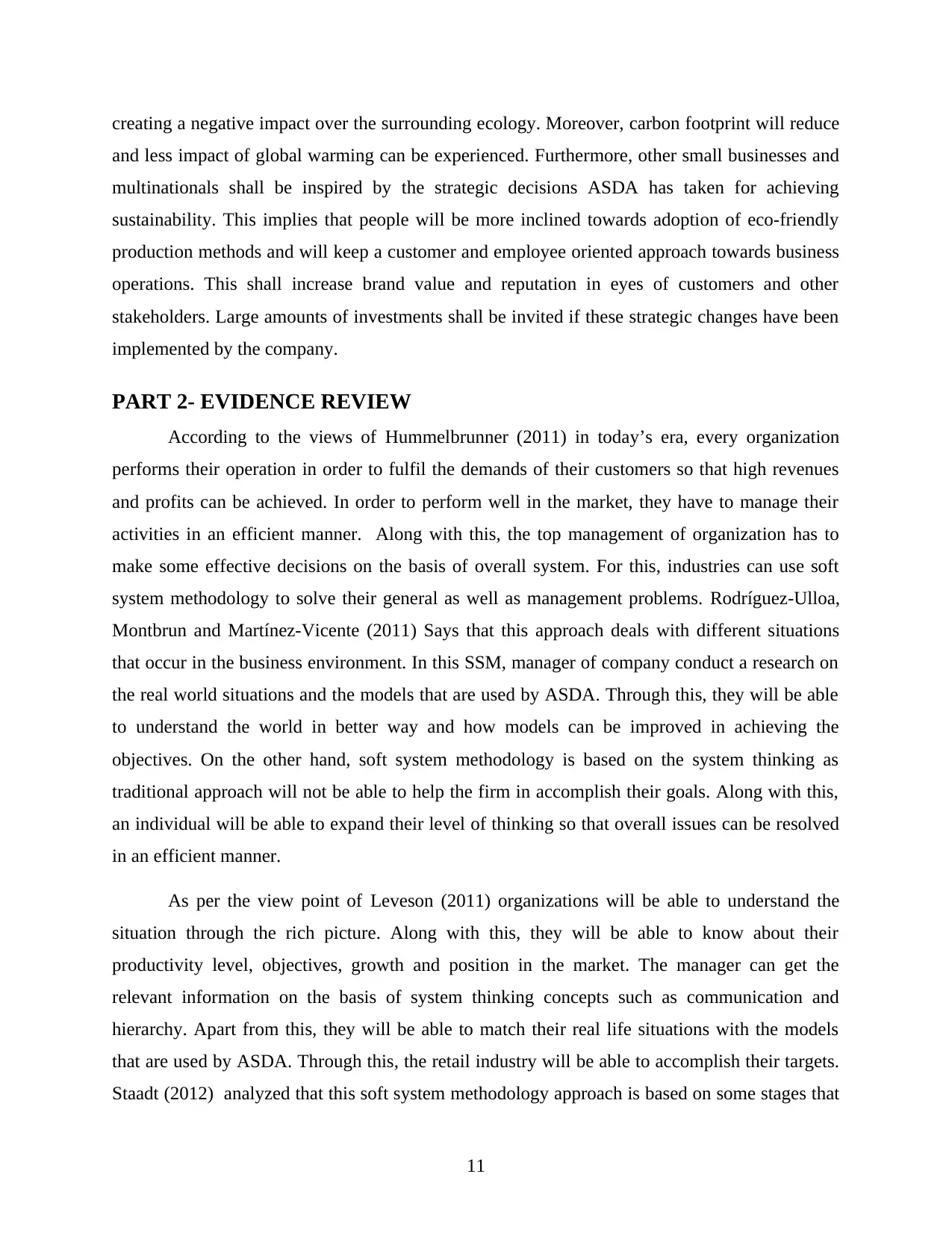
creating a negative impact over the surrounding ecology. Moreover, carbon footprint will reduce
and less impact of global warming can be experienced. Furthermore, other small businesses and
multinationals shall be inspired by the strategic decisions ASDA has taken for achieving
sustainability. This implies that people will be more inclined towards adoption of eco-friendly
production methods and will keep a customer and employee oriented approach towards business
operations. This shall increase brand value and reputation in eyes of customers and other
stakeholders. Large amounts of investments shall be invited if these strategic changes have been
implemented by the company.
PART 2- EVIDENCE REVIEW
According to the views of Hummelbrunner (2011) in today’s era, every organization
performs their operation in order to fulfil the demands of their customers so that high revenues
and profits can be achieved. In order to perform well in the market, they have to manage their
activities in an efficient manner. Along with this, the top management of organization has to
make some effective decisions on the basis of overall system. For this, industries can use soft
system methodology to solve their general as well as management problems. Rodríguez-Ulloa,
Montbrun and Martínez-Vicente (2011) Says that this approach deals with different situations
that occur in the business environment. In this SSM, manager of company conduct a research on
the real world situations and the models that are used by ASDA. Through this, they will be able
to understand the world in better way and how models can be improved in achieving the
objectives. On the other hand, soft system methodology is based on the system thinking as
traditional approach will not be able to help the firm in accomplish their goals. Along with this,
an individual will be able to expand their level of thinking so that overall issues can be resolved
in an efficient manner.
As per the view point of Leveson (2011) organizations will be able to understand the
situation through the rich picture. Along with this, they will be able to know about their
productivity level, objectives, growth and position in the market. The manager can get the
relevant information on the basis of system thinking concepts such as communication and
hierarchy. Apart from this, they will be able to match their real life situations with the models
that are used by ASDA. Through this, the retail industry will be able to accomplish their targets.
Staadt (2012) analyzed that this soft system methodology approach is based on some stages that
11
and less impact of global warming can be experienced. Furthermore, other small businesses and
multinationals shall be inspired by the strategic decisions ASDA has taken for achieving
sustainability. This implies that people will be more inclined towards adoption of eco-friendly
production methods and will keep a customer and employee oriented approach towards business
operations. This shall increase brand value and reputation in eyes of customers and other
stakeholders. Large amounts of investments shall be invited if these strategic changes have been
implemented by the company.
PART 2- EVIDENCE REVIEW
According to the views of Hummelbrunner (2011) in today’s era, every organization
performs their operation in order to fulfil the demands of their customers so that high revenues
and profits can be achieved. In order to perform well in the market, they have to manage their
activities in an efficient manner. Along with this, the top management of organization has to
make some effective decisions on the basis of overall system. For this, industries can use soft
system methodology to solve their general as well as management problems. Rodríguez-Ulloa,
Montbrun and Martínez-Vicente (2011) Says that this approach deals with different situations
that occur in the business environment. In this SSM, manager of company conduct a research on
the real world situations and the models that are used by ASDA. Through this, they will be able
to understand the world in better way and how models can be improved in achieving the
objectives. On the other hand, soft system methodology is based on the system thinking as
traditional approach will not be able to help the firm in accomplish their goals. Along with this,
an individual will be able to expand their level of thinking so that overall issues can be resolved
in an efficient manner.
As per the view point of Leveson (2011) organizations will be able to understand the
situation through the rich picture. Along with this, they will be able to know about their
productivity level, objectives, growth and position in the market. The manager can get the
relevant information on the basis of system thinking concepts such as communication and
hierarchy. Apart from this, they will be able to match their real life situations with the models
that are used by ASDA. Through this, the retail industry will be able to accomplish their targets.
Staadt (2012) analyzed that this soft system methodology approach is based on some stages that
11
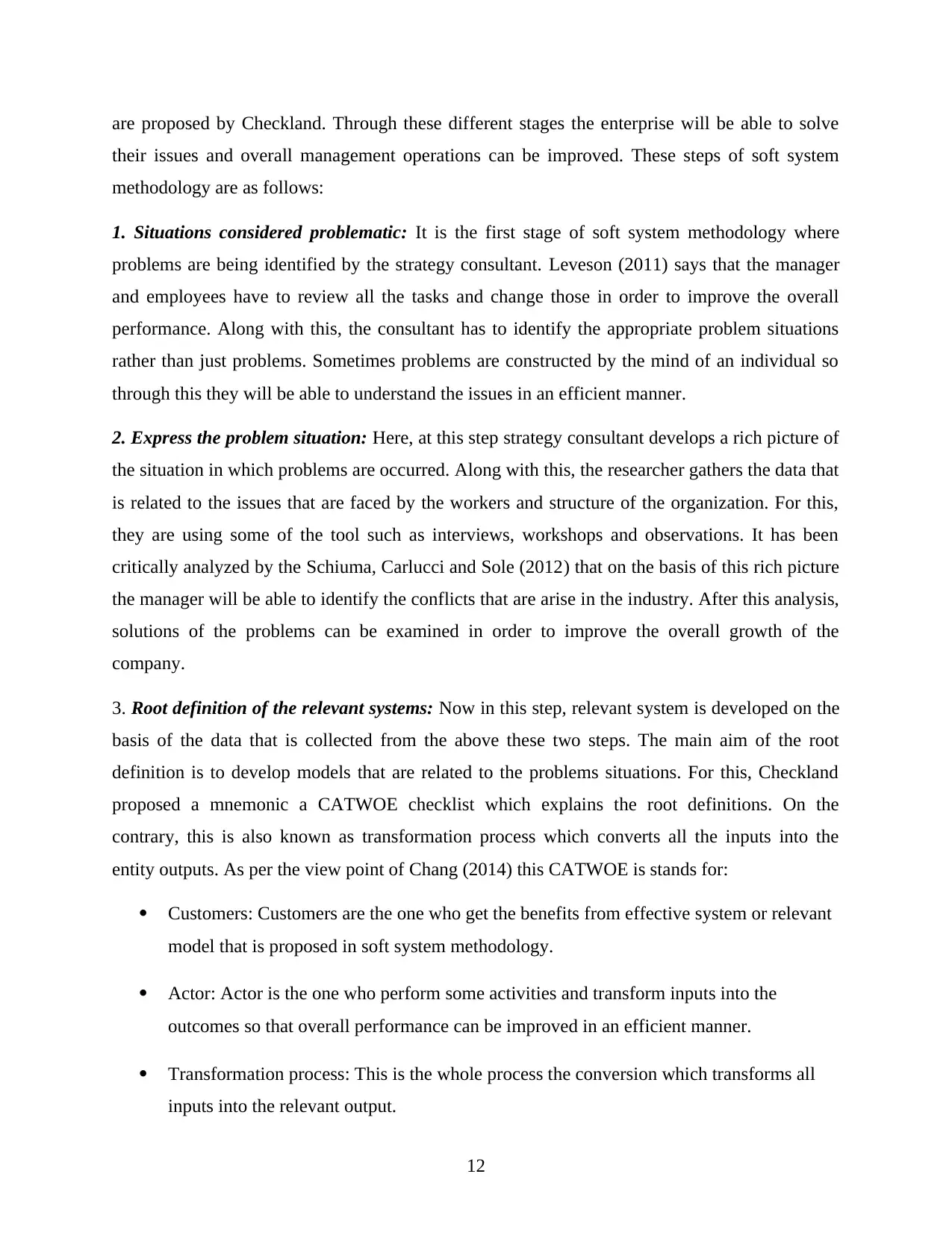
are proposed by Checkland. Through these different stages the enterprise will be able to solve
their issues and overall management operations can be improved. These steps of soft system
methodology are as follows:
1. Situations considered problematic: It is the first stage of soft system methodology where
problems are being identified by the strategy consultant. Leveson (2011) says that the manager
and employees have to review all the tasks and change those in order to improve the overall
performance. Along with this, the consultant has to identify the appropriate problem situations
rather than just problems. Sometimes problems are constructed by the mind of an individual so
through this they will be able to understand the issues in an efficient manner.
2. Express the problem situation: Here, at this step strategy consultant develops a rich picture of
the situation in which problems are occurred. Along with this, the researcher gathers the data that
is related to the issues that are faced by the workers and structure of the organization. For this,
they are using some of the tool such as interviews, workshops and observations. It has been
critically analyzed by the Schiuma, Carlucci and Sole (2012) that on the basis of this rich picture
the manager will be able to identify the conflicts that are arise in the industry. After this analysis,
solutions of the problems can be examined in order to improve the overall growth of the
company.
3. Root definition of the relevant systems: Now in this step, relevant system is developed on the
basis of the data that is collected from the above these two steps. The main aim of the root
definition is to develop models that are related to the problems situations. For this, Checkland
proposed a mnemonic a CATWOE checklist which explains the root definitions. On the
contrary, this is also known as transformation process which converts all the inputs into the
entity outputs. As per the view point of Chang (2014) this CATWOE is stands for:
Customers: Customers are the one who get the benefits from effective system or relevant
model that is proposed in soft system methodology.
Actor: Actor is the one who perform some activities and transform inputs into the
outcomes so that overall performance can be improved in an efficient manner.
Transformation process: This is the whole process the conversion which transforms all
inputs into the relevant output.
12
their issues and overall management operations can be improved. These steps of soft system
methodology are as follows:
1. Situations considered problematic: It is the first stage of soft system methodology where
problems are being identified by the strategy consultant. Leveson (2011) says that the manager
and employees have to review all the tasks and change those in order to improve the overall
performance. Along with this, the consultant has to identify the appropriate problem situations
rather than just problems. Sometimes problems are constructed by the mind of an individual so
through this they will be able to understand the issues in an efficient manner.
2. Express the problem situation: Here, at this step strategy consultant develops a rich picture of
the situation in which problems are occurred. Along with this, the researcher gathers the data that
is related to the issues that are faced by the workers and structure of the organization. For this,
they are using some of the tool such as interviews, workshops and observations. It has been
critically analyzed by the Schiuma, Carlucci and Sole (2012) that on the basis of this rich picture
the manager will be able to identify the conflicts that are arise in the industry. After this analysis,
solutions of the problems can be examined in order to improve the overall growth of the
company.
3. Root definition of the relevant systems: Now in this step, relevant system is developed on the
basis of the data that is collected from the above these two steps. The main aim of the root
definition is to develop models that are related to the problems situations. For this, Checkland
proposed a mnemonic a CATWOE checklist which explains the root definitions. On the
contrary, this is also known as transformation process which converts all the inputs into the
entity outputs. As per the view point of Chang (2014) this CATWOE is stands for:
Customers: Customers are the one who get the benefits from effective system or relevant
model that is proposed in soft system methodology.
Actor: Actor is the one who perform some activities and transform inputs into the
outcomes so that overall performance can be improved in an efficient manner.
Transformation process: This is the whole process the conversion which transforms all
inputs into the relevant output.
12
⊘ This is a preview!⊘
Do you want full access?
Subscribe today to unlock all pages.

Trusted by 1+ million students worldwide
1 out of 20
Related Documents
Your All-in-One AI-Powered Toolkit for Academic Success.
+13062052269
info@desklib.com
Available 24*7 on WhatsApp / Email
![[object Object]](/_next/static/media/star-bottom.7253800d.svg)
Unlock your academic potential
Copyright © 2020–2025 A2Z Services. All Rights Reserved. Developed and managed by ZUCOL.





